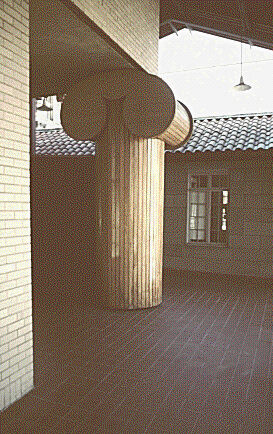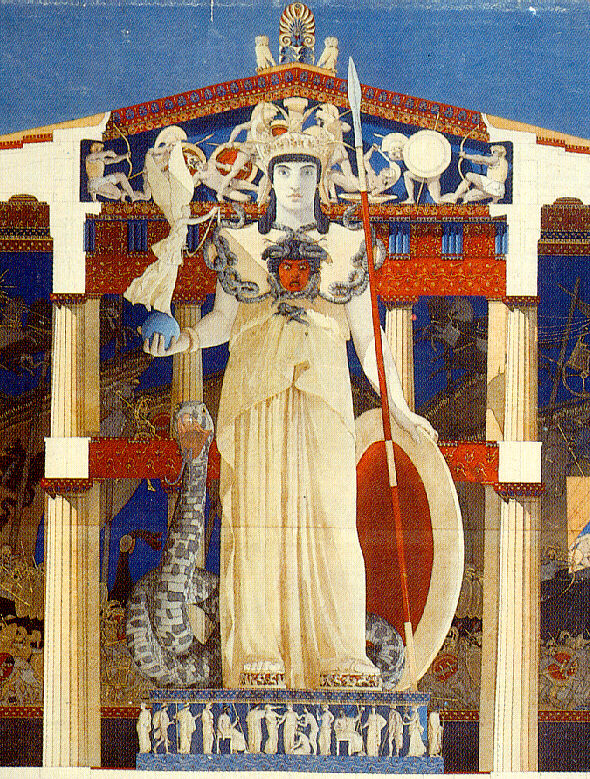2005.09.08 15:08
Hadrian was born in Spain
Ludwig was not an architect but he was more than a patron. He was a (very wealthy) King, and his actions were very much a studied reenactment of past kings/rulers. Ludwig set out to manifest culture via the arts (as opposed to manifesting wars). That Ludwig was very interested in manifesting architecture is without question.
2005.09.08 16:18
Hadrian was born in Spain
Ludwig II's architecture is no doubt aesthetically over the top, but in terms of craftsmanship, it is all top notch. It is fair to say that Ludwig's architecture inspired a lot of kitsch. Reenactionary Architecturism addresses the disticntion between popular sentimentality and reenactionary architecturism, and Ludwig II's architecture is a main point in that distinction.
2005.09.08 17:48
Hadrian was born in Spain
Hadrian had his tomb built because the tomb of Augustus had no more spaces left for an emperor.
Hadrian's Villa can also be seen as a "laboratory" of reenactment in that different parts of the villa are named for and perhaps even meant to evoke other places within the empire.
Check out the emperor Elagabalus as a latter-day Nero and then some. He had the Sessorian Palace built, which was a little Roman theme park in that besides the Palace there was also a circus and an amphitheater. What's left of the Sessorian Palace compound is at Santa Croce in Gerusalemme. A hundred or so years after Elagabalus, Helena took up residence at the Sessorian Palace.
2005.10.01 12:29
HATE
Modern art always "projects itself into a twilight zone where no values are fixed, he [Leo Steinberg] said. "It is always born in anxiety." Not only that, he said, it is the function of really valuable new Modern art to "transmit this anxiety to the spectator," so that when he looks at it, he is thrown into "a genuine existential predicament." This is basically Greenberg's line, of course--"all profoundly original art looks ugly at first"--but Steinberg made the feeling seem deeper (and a bit more refined). The clincher was Steinberg's own confession of how he had first disliked [Jasper] Johns's work. He had resisted it. He had fought to cling to his old values--and then realized he was wrong. This filtered down as a kind of Trubulence Theorem. If a work of art or a new style disturbed you, it was probably good work. If you hated it--it was probably great.
--Tom Wolfe, The Painted Word
2005.10.13 13:41
Jimmy Venturi's new website...
Was Complexity and Contradiction in Architecture really "earth shattering?" Did it really change architectural history?
I was only 10 years old when C&C was published so I can't give any personal experience as to what happened then, but a few years ago someone at design-l wrote that "nobody read that precious book back then. Go and read the [bad?] reviews it got." I haven't checked out any of the reviews, but they are certainly a legitimate part of the continuum. C&C was not in the adult section of my local free library in 1972, but it was at the Northeast (Philadelphia) Regional library, and I can still remember seeing it for the first time. It looked "foreign" to me, clinical even, and once I started reading it, it just got worse--first sentence: "This is not an easy book," and that remained true for me in 1972. I bought my own copy of C&C at MoMA in 1975 (now a first year architecture student), and I started reading it again. I mentioned my reading to one of my teachers, Maria Romanach (daughter of Mario Romanach, sometime supplier of Cuban cigars to Mies van der Rohe), and she said, "Yeah, but you don't want to design that way!"
So, how many architects have since Complexity and Contradiction in Architecture designed:
nonstraightforward architecture
ambiguous architecture
complex and contradictory architecture vs. simple and picturesque architecture
"both-and" architecture
double-functioning element architecture
contradiction adapted architecture
contradiction juxtaposed architecture
different outside and inside architecture
difficult whole architecture
?
Are any of the above "architectures" really discussed when Post-Modern Architecture is discussed?
Charles Jencks published The Language of Post-Modern Architecture in 1977.
October 1977, the cover of Progressive Architecture looked almost exactly like this:

and the copy-cats were now uncontrollably out of the bag. I remember professors in school being literally afraid that students would start doing the same thing.
| |
2005.10.13 14:40
Jimmy Venturi's new website...
To further flesh out the continuum, I was at MoMA in 1975 to see:
The Architecture of the École des Beaux-Arts
an exhibition presented at the Museum of Modern Art, New York, October 29, 1975-January 4, 1976.
Funny time those Seventies.

Benoît Loviot, Parthenon (cross-section, restored, 1880), detail.
| |
2005.11.16 09:52
Las Vegas: An Unconventional History
Anyone else watch AMERICAN EXPERIENCE - Las Vegas: An Unconventional History? I was surprised at how much I learned from this 3 hour program. It was like "Learning from the City of Antithesis" -- very "if it's no where else, it's here."
Sin City and Bust! Talk about having your cake and eating it too!
Do you think above-ground nuclear bomb testing will ever be revived for it's tourist attraction fall-out?
Did that veteran showgirl really say that Vegas during the disco era was the best?!? Gosh, you learn something new everyday.
2005.11.16 10:32
Las Vegas: An Unconventional History
The first 90 minutes are very worthwhile in that how Las Vegas started and continued to happen (against the odds) is presented clearly and engagingly. I never really knew how Las Vegas was like the exact opposite of all other American cities in that what was illegal everywhere else (including citizens) were, like magic almost, legal in Las Vegas. It's like "who was kidding who?" As if all other American cities were bastions of morality, even.
Las Vegas as capital of Native America?
2006.01.18 13:00
what is the good source to study folding architecture?
And here I thought that folding architecture had to do with simply taking a building plan and then folding it. Boy, I'm glad I never told anyone else this before because they'd surely think I was just plain stupid. I mean, I didn't know that the point was not so much to fold, but rather to tie architecture up in theoretical knots where even the architects doing it don't even know that what they are really doing is advertising (more than selling) what they think is a definite Zeitgeist reality. And what? Now it's just a quondam trend or fad that's still over-intellectualized.
2006.01.18 16:08
what is the good source to study folding architecture?
James Stirling used to talk about taking an evolutionary approach to architectural design, rather than take a revolutionary approach to architectural design.
rhetorical question:
Is folded architecture evolving, or is it extinct?
2006.01.18 17:39
what is the good source to study folding architecture?
MMatt wrote:
"What French is trying to make sure everyone understands here is that "folding" isn't a technique or a style, it's an entire school of thought (philosophically) with just as much theory and thick readings to defend/quantify it as any decon or other pomo sub-strands."
Personally, I've lost most of the confidence I've ever had in this type of sentiment/position as it relates to architectural design. Nonetheless, what MMatt wrote does reflect how most student architects are now trained to think about design, technique or style.
Yet, when it really comes down to an architectural design, folding architecture really does boil down to what it looks like. So, as far as I'm concerned, folding architecture is just another form, in the long history of forms, that architecture can take on, and, like jlxarchitect says, "if it can solve my office's project's problem, then it is Ok to use."
Otherwise, the notion of "an entire school of [failed?] thought" is stillborn, rather than being something within the evolutionary continuum of architectural design. And just because it's what is taught in school doesn't necessarily make it the truth. For example, the "Metabolist" architects of Japan talked a lot about architecture reflecting "life giving" forms, while at the same time appearing oblivious to the fact that metabolism as a operation is a creative/destructive duality. Likewise, everything Tafuri and Eisenman said/say about Piranesi's Ichnographia Campus Martius is just plain incorrect, yet their mistakes are taught and published over and over again.
I hope you all now understand what I mean by saying that I've lost confidence...
2006.01.25 13:53
Blade-runner
Reenactment, in the philosophy of history sense of the word, is certainly an excellent mnemonic device.
"Say again. Replicants are a mnemonic device?"
2006.01.25 14:19
The Beginning of a Semester, or Some Meditations on...
Enrique, my mother was working as cook at the Baron von Ow villa in Harlaching when the Allies first bombed Munich. Harlaching, a wealthy neighborhood, seemed to be one of the targets, maybe because Rudolph Hess's (empty?) villa was just around the corner from the von Ow's. January two years ago I asked my mother to tell me all about the experience. Franziska Baroness von Ow, the daughter and youngest son, the upstairs maid and my mother huddled in the basement, while Konrad Baron von Ow and the two older sons were outside--did the Baron maybe have a rifle with him? One of the houses down the street toward Theodelinden Platz was badly hit. My mother remembers carrying blankets for the Baroness as they, and the whole neighborhood actually, went down to aid the victims.
|